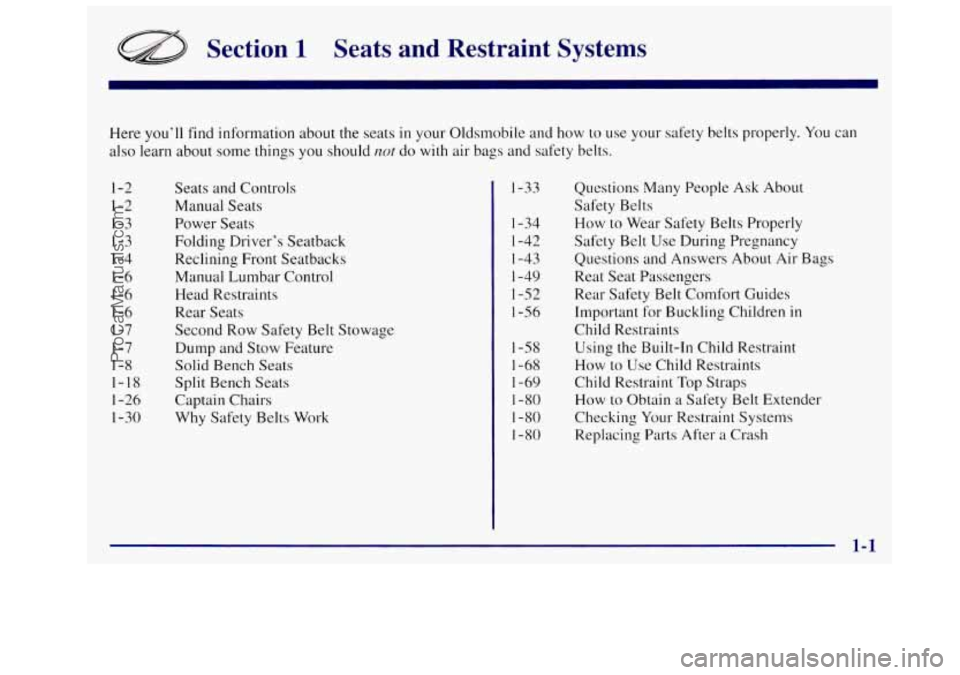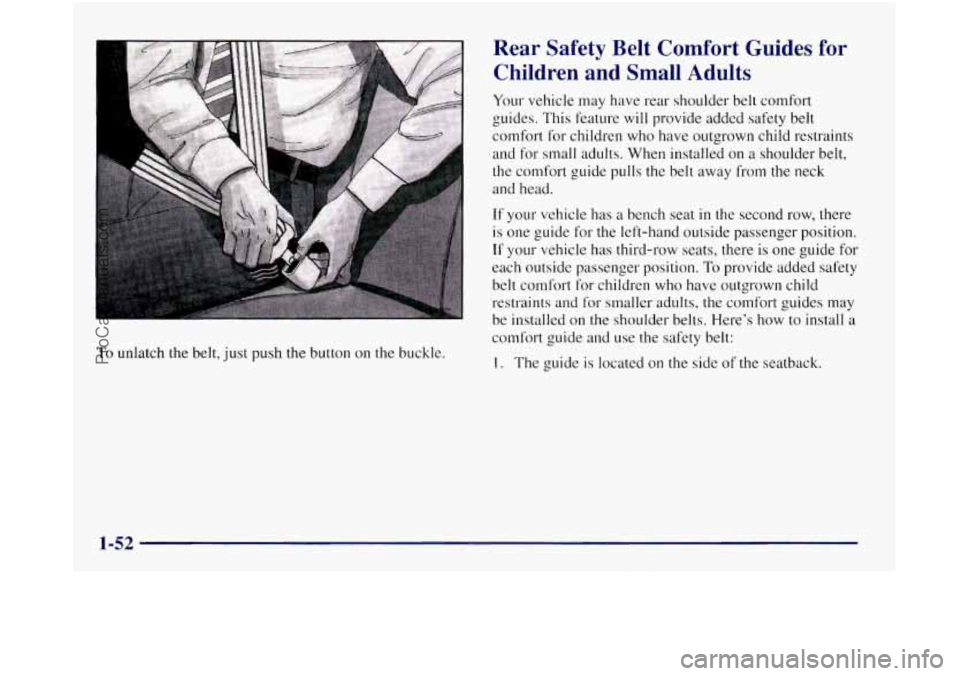child seat OLDSMOBILE SILHOUETTE 1997 Owners Manual
[x] Cancel search | Manufacturer: OLDSMOBILE, Model Year: 1997, Model line: SILHOUETTE, Model: OLDSMOBILE SILHOUETTE 1997Pages: 436, PDF Size: 21.87 MB
Page 9 of 436

Section 1 Seats and Restraint Systems
Here you’ll find information about the seats in your Oldsmobile and how to use your safety belts properly. You can
also learn about some things you should
not do with air bags and safety belts.
1-2
1-2
1-3
1-3
1 -4
1-6
1-6
1-6
1-7 1-7
1-8
1-18
1-26
1-30 Seats
and Controls
Manual Seats
Power Seats
Folding Driver’s Seatback
Reclining Front Seatbacks
Manual Lumbar Control
Head Restraints
Rear Seats Second Row Safety Belt Stowage
Dump and Stow Feature
Solid Bench Seats
Split Bench Seats
Captain Chairs
Why Safety Belts Work 1-33
1-34
1-42 1-43
1-49
1-52
1-56
1-58
1-68
1-69
1-80 1-80
1-80 Questions
Many People Ask About
Safety Belts
How to Wear Safety Belts Properly
Safety Belt Use During Pregnancy
Questions and Answers About Air Bags
Reat Seat Passengers
Rear Safety Belt Comfort Guides
Important for Buckling Children
in
Child Restraints
Using the Built-In Child Restraint
How to Use Child Restraints
Child Restraint Top Straps
How to Obtain a Safety Belt Extender
Checking Your Restraint Systems
Replacing Parts After
a Crash
ProCarManuals.com
Page 26 of 436

,A LAUTION:
c-- 1
A seat that isn’t locked into place properly can
move around in
a collision or sudden stop. People
in the vehicle could be injured. Be sure to lock
the seat into place properly when installing it.
7. Pull the nylon strap on the back of the seat and raise
the seatback
until it locks upright.
8. Push and pull on the seatback to check that it is
locked into place.
If
the seatback isn’t locked, it could move
forward in a sudden stop
or crash. That could
cause injury to the person sitting there. Always
press rearward on the seatback to be sure it
is locked.
Split Bench Seats
If you have the split bench seat (50/50 or 40/60), the
seatbacks can be folded down individually and the
sections can be removed individually. The sections can
also be adjusted forward or rearward individually.
The second row
(40/60) split bench may be equipped
with built-in child restraint(s). See “Built-In Child
Restraint”
in the Index.
Folding or Reclining the Seatbacks
To fold down the seatback on either section of the split
bench seat,
pull the nylon strap on the back of the seat or
lift up on the lever on the front of the seatback.
I Use the lever on the front
of the seatback to raise or
1 lower the seatback to the
l desired position.
1-18
ProCarManuals.com
Page 42 of 436

How to Wear Safety Belts Properly
Adults
This part is only for people of adult size.
Be aware
that there are special things to know about safety
belts and children. And there are different rules for smaller
children and babies. If a child will be riding
in your
Oldsmobile, see the part
of this manual called “Children.”
Follow those rules for everyone’s protection.
First, you’ll want
to know which restraint systems your
vehicle has.
We’ll start with the driver position.
Driver Position
This part describes the driver’s restraint system.
Lap-Shoulder Belt
The driver has a lap-shoulder belt. Here’s how to wear
it properly.
1. Close and lock the door.
2. Adjust the seat (to see how, see “Seats” in the Index)
so you can sit up straight.
3. Pick up the latch plate and pull the belt across you.
Don’t let
it get twisted.
The shoulder belt may lock
if you puli the belt across
you very quickly.
If this happens, let the belt go back
slightly to unlock
it. Then pull the belt across you
more slowly.
1-34
ProCarManuals.com
Page 60 of 436

Rear Safety Belt Comfort Guides for Children and Small Adults
Your vehicle may have rear shoulder belt comfort
guides. This ,feature will provide added safety belt
comfort for children who have outgrown child restraints
and for small adults. When installed on a shoulder belt,
the comfort guide pulls the belt away from the neck
and head.
If your vehicle has a bench seat in the second row, there
is one guide for the left-hand outside passenger position.
If your vehicle has third-row seats, there is one guide for
each outside passenger position.
To provide added safety
belt comfort for children who have outgrown child
9 restraints and for smaller adults, the comfort guides may
be installed on the shoulder belts. Here’s how to install a
comfort guide and use the safety belt:
I. The guide is located on the side of the seatback. To unlatch the belt, just push the button on the buckle.
1-52
ProCarManuals.com
Page 66 of 436

Built-in Child Restraint (Option) This child restraint system conforms to all applicable
Federal Motor Vehicle Safety Standards.
.
Each child restraint is designed for use only by children
who weigh between
22 and 40 pounds (10 and 18 kg)
and whose height is between
33.5 and 40 inches
(850 and 1 0 I6 km) and who are capable of sitting
upright alone.
The child should also be at least one year old. It is
important to use a rear-facing infant restraint
until the
child is about a year old.
A rear-facing restraint gives
the infant’s head, neck and body the support they would
need
in a crash. See “Child Restraints” later in this
section for more information.
If your vehicle has this option in a 60/40 bench seat,
there’s a built-in child restraint at each outboard position
of the
60/40 bench seat. This bench seat will only fit in
the second row
of your vehicle.
1-58
ProCarManuals.com
Page 67 of 436

Q: What if the top of my child’s shoulders is above
the shoulder belt slots for the five-point child
restraint harness system?
A: A child whose shoulders are above the shoulder
belt slots for the five-point child restraint harness
system shouldn’t use
this child restraint. Instead,
the child should sit on the vehicle’s regular seat
cushion and use the vehicle’s adult safety belts.
BEFORE YOU USE THIS CHILD RESTRAINT,
BE SURE THE TOP OF THE CHILD’S
SHOULDERS IS BELOW THE SLOTS THAT
THE HARNESS GOES THROUGH.
A CHILD
WHOSE SHOULDERS ARE ABOVE THOSE
SLOTS COULD BE INJURED DURING
A
SUDDEN STOP OR CRASH. IF THE TOP OF
THE CHILD’S SHOULDERS IS ABOVE THE
SLOTS, DON’T USE THIS CHILD
RESTRAINT WHILE THE VEHICLE IS
IN MOTION.
Securing a Child in the Built-In
Child Restraint
1. Raise the head restraint until the lower edge of the
head restraint is even with the top of the seatback.
1-59
ProCarManuals.com
Page 68 of 436

2. Rotate the head restraint rearward until it touches the 3. Lower the child restraint cushion.
top
of the seatback. Make sure there is no gap
between the lower edge
of the head restraint and the
top
of the seatback.
1-60
ProCarManuals.com
Page 69 of 436

You’ll be using the child restraint’s harness (A) to
secure your child. Don’t use the vehicle’s safety belts.
/A CAUTION:
Using the vehicle’s regular safety belts on a child
seated on the child restraint cushion
can cause
serious injury to the child in a sudden stop
or
crash. If a child is the proper size for the built-in
child restraint, secure the child using the child
restraint’s harness. But children who are too
large
for the built-in child restraint should sit on
the vehicle’s regular seat and use the vehicle’s
adult safety belts.
WARNING! FAILURE TO FOLLOW THE
MANUFACTURER’S INSTRUCTIONS ON THE
USE OF THIS CHILD RESTRAINT
SYSTEM
CAN RESULT IN YOUR CHILD STRIKING THE
VEHICLE’S INTERIOR DURING
A SUDDEN
STOP OR CRASH. SNUGLY ADJUST THE
BELTS PROVIDED WITH THIS CHILD
RESTRAINT AROUND YOUR CHILD.
ProCarManuals.com
Page 70 of 436

4. Before placing the child in the child restraint, add
slack to the shoulder harness. Pull the black shoulder
harness release strap firmly. At the same time pull
both shoulder harness straps through the slots in the
seatback as shown.
5. Place the child on the child restraint cushion.
6. Select only one side of the harness. Place the harness
over the child’s shoulder.
7. Push the latch plate (B) into the buckle until it clicks.
Be sure the buckle
is free of any foreign objects that
may prevent you from securing the latch plates.
If
you can’t secure a latch plate, see your Oldsmobile
retailer for service before using the child restraint.
1-62
ProCarManuals.com
Page 73 of 436

13. Adjust the position of the harness on the child’s
shoulder by moving the clip up
or down along the
harness.
On each side of the harness, the shoulder
part should be centered on the child’s shoulder. The
harness should be away
from the child’s face and
neck, but not falling from the child’s shoulders.
Removing the Child from the Built-In
Child Restraint
1. Unfasten the shoulder harness clip.
If you expect that the child will sleep while riding,
you can recline the seatback. See “Seats”
in
the Index.
1-65
ProCarManuals.com